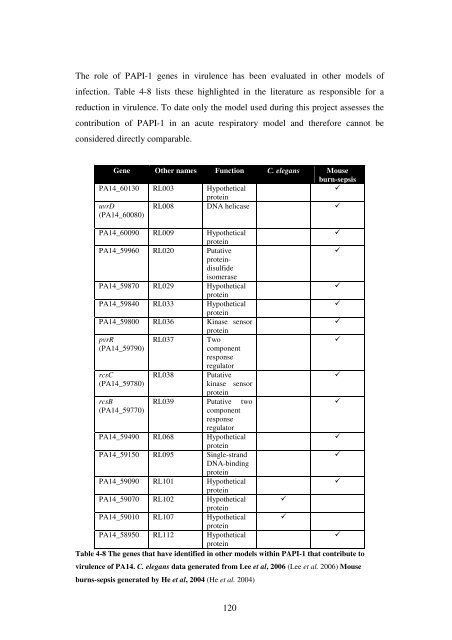5 The role of quorum-sensing in the virulence of Pseudomonas ...
5 The role of quorum-sensing in the virulence of Pseudomonas ...
5 The role of quorum-sensing in the virulence of Pseudomonas ...
You also want an ePaper? Increase the reach of your titles
YUMPU automatically turns print PDFs into web optimized ePapers that Google loves.
<strong>The</strong> <strong>role</strong> <strong>of</strong> PAPI-1 genes <strong>in</strong> <strong>virulence</strong> has been evaluated <strong>in</strong> o<strong>the</strong>r models <strong>of</strong><br />
<strong>in</strong>fection. Table 4-8 lists <strong>the</strong>se highlighted <strong>in</strong> <strong>the</strong> literature as responsible for a<br />
reduction <strong>in</strong> <strong>virulence</strong>. To date only <strong>the</strong> model used dur<strong>in</strong>g this project assesses <strong>the</strong><br />
contribution <strong>of</strong> PAPI-1 <strong>in</strong> an acute respiratory model and <strong>the</strong>refore cannot be<br />
considered directly comparable.<br />
Gene O<strong>the</strong>r names Function C. elegans Mouse<br />
burn-sepsis<br />
PA14_60130 RL003 Hypo<strong>the</strong>tical<br />
prote<strong>in</strong><br />
�<br />
uvrD<br />
(PA14_60080)<br />
RL008 DNA helicase �<br />
PA14_60090 RL009 Hypo<strong>the</strong>tical<br />
prote<strong>in</strong><br />
�<br />
PA14_59960 RL020 Putative<br />
prote<strong>in</strong>disulfide<br />
isomerase<br />
�<br />
PA14_59870 RL029 Hypo<strong>the</strong>tical<br />
prote<strong>in</strong><br />
�<br />
PA14_59840 RL033 Hypo<strong>the</strong>tical<br />
prote<strong>in</strong><br />
�<br />
PA14_59800 RL036 K<strong>in</strong>ase sensor<br />
prote<strong>in</strong><br />
�<br />
pvrR<br />
RL037 Two<br />
�<br />
(PA14_59790)<br />
component<br />
response<br />
regulator<br />
rcsC<br />
RL038 Putative<br />
�<br />
(PA14_59780)<br />
k<strong>in</strong>ase sensor<br />
prote<strong>in</strong><br />
rcsB<br />
RL039 Putative two<br />
�<br />
(PA14_59770)<br />
component<br />
response<br />
regulator<br />
PA14_59490 RL068 Hypo<strong>the</strong>tical<br />
prote<strong>in</strong><br />
�<br />
PA14_59150 RL095 S<strong>in</strong>gle-strand<br />
DNA-b<strong>in</strong>d<strong>in</strong>g<br />
prote<strong>in</strong><br />
�<br />
PA14_59090 RL101 Hypo<strong>the</strong>tical<br />
prote<strong>in</strong><br />
�<br />
PA14_59070 RL102 Hypo<strong>the</strong>tical<br />
prote<strong>in</strong><br />
�<br />
PA14_59010 RL107 Hypo<strong>the</strong>tical<br />
prote<strong>in</strong><br />
�<br />
PA14_58950 RL112 Hypo<strong>the</strong>tical<br />
prote<strong>in</strong><br />
�<br />
Table 4-8 <strong>The</strong> genes that have identified <strong>in</strong> o<strong>the</strong>r models with<strong>in</strong> PAPI-1 that contribute to<br />
<strong>virulence</strong> <strong>of</strong> PA14. C. elegans data generated from Lee et al, 2006 (Lee et al. 2006) Mouse<br />
burns-sepsis generated by He et al, 2004 (He et al. 2004)<br />
120














